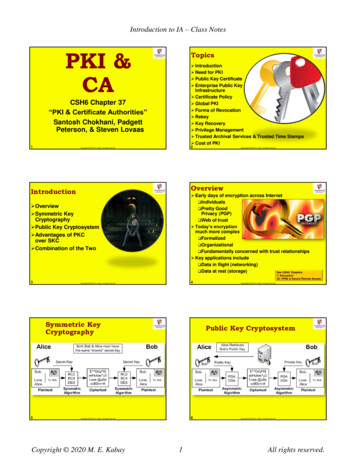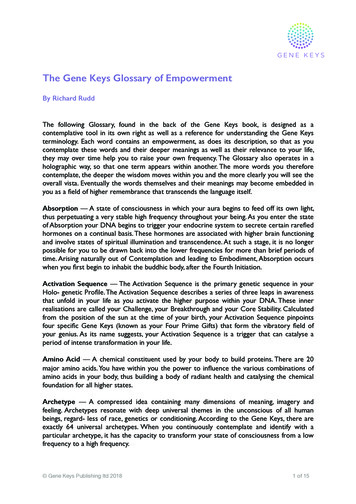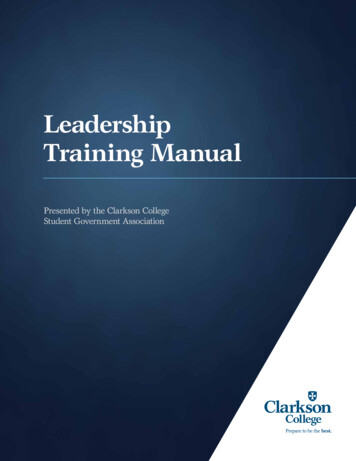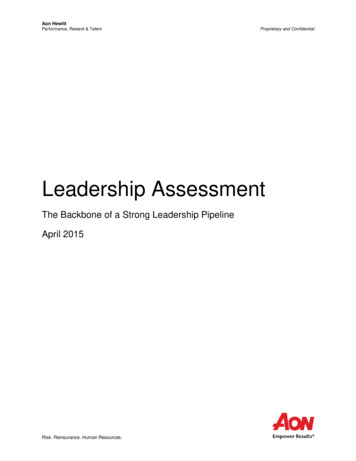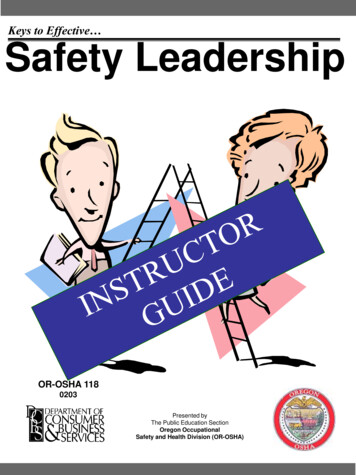
Transcription
Keys to Effective Safety LeadershipOR-OSHA 1180203Presented byThe Public Education SectionOregon OccupationalSafety and Health Division (OR-OSHA)
OR-OSHA Mission StatementTo advance and improve workplace safety and health for all workers in Oregon.OR-OSHA ServicesOregon OSHA offers a variety of safety and health services to employers and employees:Consultative Services (all field offices)Offers no-cost, confidential on-site safety, health, and ergonomic assistance to Oregon employers for help inrecognizing and correcting safety and health problems in their workplaces.Our consultants can also introduce you to the Safety & Health Achievement Recognition Program (SHARP)and Oregon’s Voluntary Protection Program (VPP).Standards and Technical Resources (Salem Central)Adopts, amends, and formally interprets occupational safety and health standards and provides technicalassistance such as reviewing variances.Operates a resource center containing books, topical files, technical periodicals, pamphlets and brochures,more than 200 technical data bases, and an audiovisual lending library.Enforcement (all field offices)Inspects places of employment for occupational safety and health rule violations and investigates workplacesafety and health accidents, complaints, and referrals.Provides compliance assistance, specific abatement assistance to employers who have received citation, andoffers pre-job conferences for construction employers.Public Education & Conferences (Portland, Salem Central, Eugene)Conducts no-cost statewide educational workshops in a wide variety of safety and health subjects.Co-sponsors statewide conferences including the biennial Governor’s Occupational Safety and HealthConference in Portland.Additional Public Education Services Safety for Small Business workshopsAward of Completion Interactive Internet coursesSafety Committee Member Training Series Training Series CertificatesThe Oregon Occupational Safety and Health Division of theDepartment of Consumer and Business Services presents thiscertificate to commend On-site training requestsYour Name Access workshop materialsFor the completion of 32 hours of training in occupationalsafety and health Spanish training aids Training and Education GrantsMichelle CattanachManagerAugust 19, 2003Date Continuing Education Units/Credit HoursFor more information on Public Educationservices, please call (888) 292-5247 Option 2Portland Field OfficeSalem Field OfficeEugene Field OfficeMedford Field OfficeBend Field OfficePendleton Field Office(503) 229-5910(503) 378-3274(541) 686-7562(541) 776-6030(541) 388-6066(541) 276-9175Check out our series of five specific safety and healthtraining program certificates!Salem Central Office: (800) 922-2689 or(503) 378-3272Web Site: www.orosha.org
This material is for training purposes onlyINSTRUCTOR’S NOTES FOR INSIDE FRONT COVERIf appropriate, discuss the various sections and services of Oregon OSHA.OR-OSHA 118 - Safety Leadership3
This material is for training purposes onlyWelcome to the Keys to Effective Safety LeadershipIn 1964, John W. Gardner was awarded the Presidential Medal of Freedom for his work in theprivate and public sectors. In his book, On Leadership, he states that “the first step toward effectiveleadership is not action, it’s understanding.” That’s what this workshop is all about. In the nextfew hours we will try to gain a better understanding of what it takes to be effective leaders asemployees, supervisors, and managers within the occupational safety and health arena. To do that,we’ll explore leadership concepts and principles, and tap into your personal knowledge andexperience.The Big Goal.Gain a greater awareness of the concepts and techniques of applying effective safetyleadership in the workplace.What's insideThe Nature of Leadership2Attila the Hun on Safety3Climbing the Leadership Ladder6Leaders understand cause and effect7Exercise - What's your leadership style 8Leaders develop a supportive culture9Leaders value safety10Form GroupsLeaders value safetyLeaders know how to communicateLeaders recognize good workLeaders know how to disciplineLeaders develop trust and credibilityLeaders demonstrate commitmentDeveloping leadership in your culture10111212131415IntroductionsElect a group leaderSelect a spokespersonEveryone’s a recorderPlease Note: This material, or any other material used to inform employers of compliance requirements of Oregon OSHA standardsthrough simplification of the regulations should not be considered a substitute for any provisions of the Oregon Safe Employment Act orfor any standards issued by Oregon OSHA. The information in workbook is intended for classroom use only.OR-OSHA 118 - Safety Leadership4
This material is for training purposes onlyINSTRUCTOR’S NOTES FOR PAGE 1.Introduce yourself. Discuss breaks, facilities, and overview the goals for the course.If the class is large you may want to break it into groups for exercises.OR-OSHA 118 - Safety Leadership5
This material is for training purposes onlyThe nature of leadershipTo figure out what leadership is, let’s first discuss what it is not.Leadership is not power The capacity to bring about desired outcomes and prevent those not desired. (Gardner) Derived from status, position, money, expertise, charisma, ability to harm, access to media,control of assets, communications skills, physical strength. Leaders always have power, but the powerful are not always leaders. Thug who sticks a gun in your back has “power” but not leadership Is self-centered, ethically neutral (can be used for good or bad), amoralLeadership is not status Status or position may enhance the opportunity for leadership (and accountability) Some may have status or position, yet haven’t a clue how to lead Position is assigned from above.leadership is conferred from below.Leadership is not authority Person may have subordinates, but not followers People will follow.confer leadership. only if person acts like a leaderLeadership is not management Management is the process of controlling systems through planning, organizing, andsupervising. Managers organize system inputs - processes, policies, plans, procedures, programs. Managing is an planned activity. Leadership is more spontaneous than planned. Managers do things right. Leaders do the right things.Leadership is not common sense Common sense - What is it? How do we develop it? Good sense is individual. Common sense would result in common leadership styles.The people are fashioned according to the example of their king; and edicts are of less power than the life(example) of the ruler. Claudian, c. 365. Egyptian epic poet.OR-OSHA 118 - Safety Leadership6
This material is for training purposes onlyINSTRUCTOR’S NOTES FOR PAGE 2.To get a better idea of what "leadership" is, we should first take a look at what it it not.Discuss the content of this page. Give examples.Safety Manager or Leader?The difference between the two can have a dramatic impact on safety performance.I spoke recently with Tom (not his real name), a safety coordinator for a Midwestconstruction company. At the safety meeting I attended, Tom’s passion and concern foremployee safety stood out — so much so that I asked him if he was a union rep! Hereplied that his attitude toward employee safety was molded in the military, where it hadbeen drilled into him that he was responsible for the welfare of his unit.When Tom told people he was in charge of teaching safety to construction workers,they frequently commented on what a thankless job that must be. Yet, Tom said that hisemployees are a very receptive audience. The only thing that puzzles Tom is that theseworkers, some of whom have been in construction for 20 years or more, have neverbeen given the safety information that he considers so vital.Tom’s missionary zeal for safety re minded me of a recent warning from managementconsultant Stanley D. Truskie. In his book, Leadership in High-PerformanceOrganizational Cultures (Quorum Books, 1999), Truskie argues that many companiesare failing to participate fully in our economic expansion because of outdatedmanagement practices. One of the widespread problems he identifies is that companiesare run by managers and supervisors who control workers, rather than by leaders whoinspire them.Because much of safety continues to focus on government regulations, many wellintentioned safety managers spend much of their time nagging others about complyingwith minimum safety standards. Safety leaders, on the other hand, keep their eye onthe ultimate goal —keeping employees safe and healthy —and employ theirenthusiasm, commitment and knowledge to achieve that goal.Tom did not intend to make safety his career, but his company recognized his passionfor safety and sought him out for the job. They were looking for a safety leader, not amanager, and they found one in Tom. (Steven G. Mintor, Editor, Occupational HazardsMagazine, March 2000, p. 6)Managers bosses primarily manage to controlLeaders primarily manage to supportHigh level leaders also inspireOR-OSHA 118 - Safety Leadership7
This material is for training purposes onlyGroup Exercise: ATTILA ON “LEADERSHIP QUALITIES”Leadership is the process of persuasion or example by which an individualor team induces a group to pursue objectives held by the leader or shared bythe leader and his or her followers. (John Gardner, On Leadership, p. 1)Instructions: Review the "Attila On “Leadership Qualities” summary onthe next two pages. Choose any three qualities and discuss how they might bedemonstrated by a safety leader. Spokesperson - be prepared to summarizeand present your group's ideas to the class.Quality:How is it demonstrated?Quality:How is it demonstrated?Quality:How is it demonstrated?OR-OSHA 118 - Safety Leadership8
This material is for training purposes onlyINSTRUCTOR’S NOTES FOR PAGE 3.Have class or groups look at the various leadership attributes as described by Attilathe Hun on pages 4 and 5.Once groups have listed attributes and discussed how they might be applied tosafety, have them present their ideas about how those attributes might bedemonstrated.OR-OSHA 118 - Safety Leadership9
This material is for training purposes onlyATTILA ON “LEADERSHIP QUALITIES”We must teach these qualities to our young warriors, if they are to develop intoable chieftains. Basic instruction in horsemanship, with the lariat, bow andlance, is sufficient for our warriors but not for those who lead them.In order to skillfully lead our nation, we must have chieftains who possess,among others, the following essential qualities, which through experiencebecome mastered skills:LOYALTY—Above all things, a Hun must be loyal. Disagreement is not necessarily disloyalty.COURAGE—Chieftains who lead our Huns must have courage. They must be fearless and have thefortitude to carry out assignments given them—the gallantry to accept the risks of leadership.DESIRE—Few Huns will sustain themselves as chieftains without strong personal desire—aninherent commitment to influencing people, processes and outcomes.EMOTIONAL STAMINA—Each higher level of leadership places increasing demands on theemotions of chieftains. We must ensure that our leaders at every level have the stamina to recoverrapidly from disappointment.PHYSICAL STAMINA—Huns must have chieftains who can endure the physical demands of theirleadership duties. Chieftains must nurture their bodies with the basic, healthful staples.EMPATHY—Chieftains must develop empathy—an appreciation for and an understanding of thevalues of others, a sensitivity for other cultures, beliefs and traditions.DECISIVENESS—Young chieftains must learn to be decisive, knowing when to act and when notto act, taking into account all facts bearing on the situation and then responsibly carrying out theirleadership role.ANTICIPATION—Learning by observation and through instincts sharpened by tested experience,our chieftains must anticipate thoughts, actions and consequences.TIMING—Essential to all acts of leadership is the timing of recommendations and actions. There isno magic formula for developing a sense of timing.COMPETITIVENESS—An essential quality of leadership is an intrinsic desire to win. It is notnecessary to win all the time; however, it is necessary to win the important contests. Chieftains mustunderstand that the competition inside and outside our nation is strong and not to be taken lightly.OR-OSHA 118 - Safety Leadership10
This material is for training purposes onlyINSTRUCTOR’S NOTES FOR PAGE 3.See page 2 notesOR-OSHA 118 - Safety Leadership11
This material is for training purposes onlySELF-CONFIDENCE—Proper training and experience develops in chieftains a personal feeling ofassurance with which to meet the inherent challenges of leadership.ACCOUNTABILITY—Learning to account for personal actions and those of subordinates isfundamental to leadership. Chieftains must never heap praise or lay blame on others for what theythem selves achieve or fail to accomplish, no matter how glorious or grave the consequences.RESPONSIBILITY—Leaders are only necessary when someone is to be responsible to see thatactions are carried out and directions followed. No king, chieftain or subordinate leader should ever beallowed to serve who will not accept full responsibility for his actions.CREDIBILITY—Chieftains must be credible. Their words and actions must be believable to bothfriend and foe. They must be trusted to have the intelligence and integrity to provide correctinformation.TENACITY—The quality of unyielding drive to accomplish assignments is a desirable and essentialquality of leadership. The weak persist only when things go their way.DEPENDABILITY—If a chieftain cannot be de pended upon in all situations to carry out his rolesand responsibilities, relieve him of them. A king can not observe each and every action of hissubordinate chieftains; therefore, he must depend upon them to get things done.STEWARDSHIP—Our leaders must have the essential quality of stewardship, a caretaker quality.They must serve in a manner that encourages confidence, trust and loyalty. Subordinates are not to beabused; they are to be guided, developed and rewarded for their performance. Punishment is to bereserved as a consequence of last resort and sparingly applied only when all other attempts have failedto encourage the rebellious to comply.Learn these leadership qualities well. Teach them to the Huns. Only then will we expand our ability tolead our vast nation in pursuit of world conquest.Source: Adapted from Leadership Secrets of Attila The Hun, Wess Roberts, Ph.D., Warner BooksOR-OSHA 118 - Safety Leadership12
This material is for training purposes onlyINSTRUCTOR’S NOTES FOR PAGE 3.See page 2 notesOR-OSHA 118 - Safety Leadership13
This material is for training purposes onlyClimbing the leadershipladderStep 5 - The Champion People follow because of who you are and whatyou represent. This step is reserved for leaders who have spentyears growing people and organizations. Few make it: Those who do are bigger than life.Step 4 - The Provider People follow because of what you do for them. This is where long-range growth occurs.Adapted from John Maxell’s Five levels ofLeadership, Developing the Leader Within You Your commitment to developing leaders will insure ongoinggrowth to the organization and to people. Do whatever you can to achieve and stay on this level.Step 3 - The Producer People follow because of what you do for the organization. This is where success is sensed by most people. They like you and what you are doing. Problems are fixed with very little effort because of momentum.Step 2 - The Coach Leadership by permission - you command, not demand. People want to follow - confer leadership on you. People will follow you beyond your stated authority. You begin developing followers into self-leaders.Step 1 - The Boss You develop dependent subordinates, not followers and certainly not self-leaders People do what you say because they have to People do what you say because you occupy a position. Your influence does not extend beyond the lines of your job description. The longer you stay here, the higher the turnover and lower the morale.OR-OSHA 118 - Safety Leadership14
This material is for training purposes onlyINSTRUCTOR’S NOTES FOR PAGE 6.Discuss the various levels of leadership. This material was adapted from Adaptedfrom John Maxell’s Five levels of Leadership, Developing the Leader Within You, andyou may want to read the text to better understand and present the material.Level one: The boss, isn't actually effective as a leadership approach because peopledo what they have to not what they want to. The "leader's" motivation is selfish.Level two: Where real leadership begins. The leader is more concerned about thesuccess of the followers.Level three: The leader is respected because they are top producers. Top producersmay be successful, but it doesn't necessarily mean leadership is conferred uponthem.Level four: We all have the ability to reach this level. This is where a successfultough caring leadership approach works best. Leadership is conferred because theleader is able to provide resources and the motivation is selfless, other-centered.Level five: Not many achieve this level. These people are bigger than life. Greatreligious, social, business leaders.OR-OSHA 118 - Safety Leadership15
This material is for training purposes onlyLeaders understand cause and effectThe leader naturally sets the tone of the safety culture and that has a direct effect on morale andperformance. Whatever the leader gives to the group will be given back. Whatever the leaderexpects will be expected of him or her. For example: If a leader wants employees who care about their work, he or she must demonstrate care foremployees. If a leader desires honest and fair employee behavior, he or she must treat employees withhonesty and fairness. If a leader expects selfless employee performance, he or she must be selfless. If a leader expects employee loyalty, he or she must be loyal.Discuss the resulting effects the following leadership approaches haveon morale and performance:CaringControllingCoercionOR-OSHA 118 - Safety Leadership16
This material is for training purposes onlyINSTRUCTOR’S NOTES FOR PAGE 7.The main point here is that leaders get what they give. If they want to be trusted, themust trust. If they want commitment, they have to demonstrate commitment.Everything the leader does creates a story the people may talk about in the lunchroom. The law of cause and effect is well established.Tough-caring leadership is really the only approach that will be successful. Toughcaring leaders insist on safety compliance (they don't just encourage it) because theycare about the safety, health, success of their employees. The primary motivation isselfless.Tough-controlling leaders are tough to make sure they, themselves, do not get introuble, because it's policy, because they are superior and employees aresubordinates, because they are more interested in their own success than thesuccess of their employees. The primary motivation is selfish. This approach willnot be successful in the long run.Tough-coercive leaders are "out of control" themselves. Because they are fearful,they create fear in their employees to get things done. They may lack confidence.They may believe they lack the ability to achieve the objectives any other way thanintimidation, coercion. They try to gain control or assure they meet objective usingthese tactics. Very selfish and very unsuccessful.Examples: Students will arrive at many conclusions. Discuss each.Coercive: Physical and psychological coercion. Short lived compliance, only whenboss is around, high anxiety, fighting, arguing, high absenteeism, sabotage,backbiting, turf wars, blaming, no creativity, not innovation, less than 100% effort,high turnover.Controlling: Compliance present but not consistent, some anxiety, work because youhave to, may get 100% effort, selfish purposes, not necessarily a happy workplace.Caring: Sustained compliance, autonomy, low anxiety, low distress, want to work,look forward to work, creativity, innovation, proactive, works to achieve success,happy workplace may get greater than 100% effort.OR-OSHA 118 - Safety Leadership17
This material is for training purposes onlyAttitude check.What’s your leadership style?Indicate what you think about each of the statements below by placing the number corresponding toyour opinion in the space provided before each statement.-3 Disagree 0 No opinion3 Somewhat agree5 Strongly agree1. The average person dislikes work: Will avoid it if possible.2. To most workers, work is as natural as play or rest.3. Workers do not need close supervision when committed to an objective.4. Workers must be directed, controlled, or threatened to perform well.5. Workers are usually committed to objectives when rewarded for achievement.6. People generally lack creative ability.7. The average worker is self-centered, not concerned with corporate objectives.8. Workers not only accept, but seek responsibility.9. The average worker has a relatively high degree of imagination and ingenuity.10. Typically, workers lack ambition, avoid responsibility.11. Workers generally seek security and economic rewards above all else.12. The average worker is capable of self-direction when motivated.Add up your score from the exercise above# 1# 2# 4# 3# 6# 5# 7# 8# 10# 9# 11# 12TotalTotalOR-OSHA 118 - Safety Leadership18
This material is for training purposes onlyINSTRUCTOR’S NOTES FOR PAGE 8.This is a fun individual exercise. It's not "scientific" just fun. It does give you an ideawhat your own leadership approach might be.If the score on the left is high when contrasted with the score on the right, it meansthat your approach may be more tough-controlling in nature. If the score is high onthe right, you may take a more tough-caring approach.A high score on the left may also indicate a "Theory X" approach. High score on theright indicates a "Theory Y" approach. See The Human Side of Enterprise: byDouglas McGregor and Warren Bennis, for more on this topic.If the left and right scores are relatively close, results are inconclusive.OR-OSHA 118 - Safety Leadership19
This material is for training purposes onlyLeaders develop a supportive cultureAsk most employees what a corporate culture is and they'll tell you, "it's the waythings are around here." Traditional safety cultures typically provide the necessarysupport for employees to strive beyond minimal efforts. Some approaches to safetyleadership fail to inspire the necessary safety-related behaviors and attitudes inemployees.When effective safety leadership is present, employees not only feel responsible for their own safety,they feel responsible for their peers' safety. An organizational culture supports them acting on thatresponsibility. Individuals have the necessary tools and methods, as well as appropriate person states(e.g., self-esteem, group belonging, personal control) to actively care for the safety of coworkers.Additionally, the organization's formal management systems and leaders' informal managementpractices facilitate actively caring by encouraging, recognizing, and reinforcing appropriate behaviors.One way to picture an organization's culture is to think of it as its "personality." Who do you think hasthe greatest influence on "the way things are around here"?Who has the greatest control over what a corporate culture looks like?Each supervisor and manager creates his or her own subcultureThe same relationship between culture and the personality of the person controlling the culture appliesto each department within the organization. Again, the department is likely to reflect the personality.thestyle and values of the department head. Since each department head demonstrates unique leadershipand management styles, each subculture is unique within an organization.How can you tell where effective safety cultures exist?OR-OSHA 118 - Safety Leadership20
This material is for training purposes onlyINSTRUCTOR’S NOTES FOR PAGE 9.Ask students what "culture" is. You may get a lot of fuzzy looks. That's because it'sreally hard to describe. It's just the way things are. What things? Discuss this.Safety will not work unless the corporate culture supports it. Training will not work ifthe employee walks out the door after a training session and the supervisor ormanager makes a negative comment about the training, or if they do not set apositive example, or they do not otherwise behave in a manner consistent with whatthe employee expects after training.The person at the top usually has most control over the culture. A culture mayactually be thought of as the "personality" of the corporate, and may reflect thenorms, values, etc of the person at the top.An effective safety culture will include messages from the top that tell employees theirjob security depends on working safe. That's what's expected. A safety culture thattells employees their job security depends only on working fast, it does not supportsafety. Employees receive messages every day and those messages may be sent inmany different ways, both the "walk" and the "talk" of which management engages.OR-OSHA 118 - Safety Leadership21
This material is for training purposes onlyLeaders value safetyPriorities vs. ValuesWe’ve all heard others talk about “valuing” safety as their “top priority,” but what does that mean?What is a priority? How does it differ from a value? Let’s explore these two terms and how theyapply.To "prioritize" means to arrange in order of importance.If we prioritize safety as #1, what message do we automatically state about the production as apriority. Is the message congruent in a production only culture? What happens to our priorities whenwhen production problems surface?To "value" means to place a belief or standard in high regard.Values do not change. We place such importance on values that, even when the going gets tough, weconsider them non-negotiable. What happens when we actually revise or prioritize what we claimare values?Exercise: Fun at Farley’sYou’re a maintenance worker at Farley’s Famous Fiskets, Inc. The companymanufactures 50,000 famous fiskets a month. Due to supply problems,production is behind schedule. Suddenly the “fisketizer” breaks down causinga plant-wide halt in production. Your supervisor tells you to fix the problem.What might be the most likely response when you tellthe supervisor that lockout/tagout is required to repairthe machine?SafetyFirst!Safe ProductionorNo Production!When the supervisor prioritizes safetyWhen the supervisor values safetyValues are Non-negotiable!OR-OSHA 118 - Safety Leadership22
This material is for training purposes onlyINSTRUCTOR’S NOTES FOR PAGE 10.You know safety is a value when it's non-negotiable. It doesn't change even whenthe going gets tough. A sign the says "Safety is Priority One" will not be believedunless safety is actually a value. Priorities, by definition, may be easily revised up ordown, depending on the situation. The values you personally have do not changeeasily.The supervisor that prioritizes safety may tell the maintenance worker to bypasssafety procedures. The work is more important than the worker.The supervisor that values safety will not tell the maintenance worker to bypasssafety procedures. The worker is more important than the work.OR-OSHA 118 - Safety Leadership23
This material is for training purposes onlyLeaders know how to communicateEffective leaders in safety communicate to establish tough-caring relationships: They establish andinsist on high standards, and they care about everyones' safety and health. They know that each andevery interaction with an employee not only relays information, but fixes or changes an importantworking relationship.Every communication sends a content and relationship message.BILL, YOU IDIOT! WEAR YOUR % #& HEARING PROTECTION!The contentmessage relaysthe data Bill, make sure you wear your hearing protection.The senderThe relationshipmessage fixes anemotional connectionThe receiverWhich message do we intend to convey?To which message does the receiver respond?What can we assume when the receiver's response to our message isnot what we expected?You do not lead by hitting people over the head.that’sassault, not leadership.Pres. Dwight D. Eisenhower.OR-OSHA 118 - Safety Leadership24
This material is for training purposes onlyINSTRUCTOR’S NOTES FOR PAGE 11.The content level communicates the data actual words.The relation level communicates motivation, attitude, intent may not be interpretedaccurately, yet it is the level that is believed. We react to what we interpret at thislevel. If you experience someone responding to you in a defensive manner, it meansyou've probably come across on this level as offensive or threatening in some way.Important to emphasize we mean “tough caring” here: regard for, or attention to thesafety and health of a co-worker in a culture of accountability. Not a love, ornecessarily even a liking for the person.What about commons sense "If is wasn’t for the lack of common sense in ouremployees, we wouldn’t have any accidents around here." It’s all their fault. It’s notmanagement’s responsibility. Employees are under control of all factors that cometogether to cause an accident.Common sense is individual. When someone asks, “Why didn’t you use yourcommon sense?” he or she is really asking, “Why didn’t you do what I would havedone?” Using common sense is always doing what makes sense to you and onlyyou.Top management/the owner, must send a value message about safety to the entirecompany. If he or she sends a mixed message to management, the message withthe greatest consequence to the manager’s own security/success will be th
Aug 19, 2003 · or team induces a group to pursue objectives held by the leader or shared by the leader and his or her followers. (John Gardner, On Leadership, p. 1) Instructions: Review the "Attila On “Leadership Qualities” summary on the next two pages. Choose any three qualities and discuss how they m



